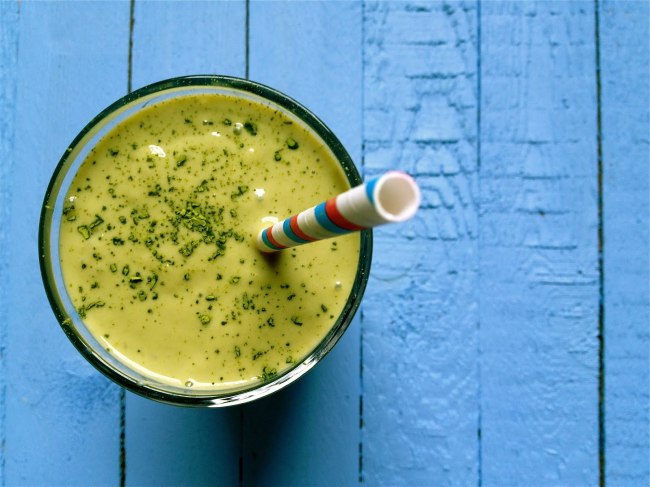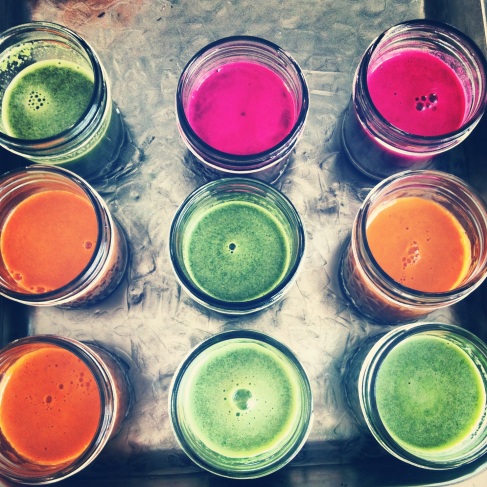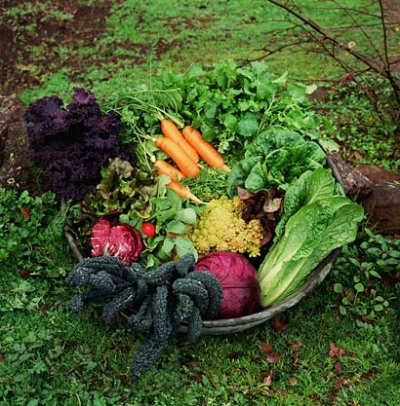- Drink more water
- Do 20 jumping jacks/ push-ups/ squats when you’re feeling lethargic
- Swap out your afternoon coffee for a brisk 10-minute walk
- Go to bed earlier – try 15 minute increments until you get to a full hour
- Stop depending on caffeine for energy, it’s draining your adrenals. Try drinking decaf every other day, or at least every other cup.
- Have an evening ritual; even five minutes of something will help
- Don’t eat after 8 pm, ESPECIALLY not sugar. It interferes with your sleep and will give you a hangover.
- Drink tea before bed
- Take a break from your workload twice a day to watch or read something inspiring
- Have something to look forward to tonight or on the weekend, whether it’s a drink with an old friend, an interesting talk, a group sport, or an exercise class with a great instructor.
Tag Archives: energy
Green and Gold Immunity Smoothie
This is one of my favorite smoothies to have in the mornings or as a post-workout snack. It’s full of protein and super energizing. Try some or all of the superfood additions, they’ll take this smoothie to a whole new level and will provide you with tons of macro and micro nutrients necessary for your radiant body and mind.
Big handful Kale (I like dino/black kale)
8 oz Rice milk (or any low sugar non-dairy milk that you enjoy)
6 pineapple squares (I like to get pre-cut from Whole Foods)
1 banana
1 tbsp. nut butter (I love raw almond butter)
½ C. ice
Optional Superfood Additions
For protein: 1 tbsp hemp seeds
For omegas and metabolism health: 1 tbsp coconut oil
For iron and protein: 1 tbsp chia seeds
For energy: 1 tsp maca
For fiber and omegas: 1 tbsp ground flax
Photo Credit: BeeGreenWorld.com
Three Juices to Smile About
Acid Wash
1 large grapefruit
2 small oranges
1 cucumber
½ bulb fennel
1 small apple
Full of fiber, this juice is hydrating, alkalizing, and gives a great boost to your immune system! The fennel is cleans out your sinuses and soothes the tummy well, good after a late night.
Youthenize Me
4 large carrots
3 celery sticks
½ cucumber
2 small oranges
The beta-carotene found in orange fruits and veggies like carrots and oranges is great for cell regeneration which keeps you looking young and fresh faced. The celery and cucumber in this will alkalize your system, combat inflammation and hydrate you, which is another big factor that combats aging.
Sweet Roots
2 Beets
1 pink lady apple
½ cucumber
¼ lemon
½ inch chunk ginger (or more, depending on how much spice you like)
Alright party people, this one’s for you. Beets are a fantastic liver cleanser, which is where your body does all of it’s detoxing, and the cucumber will help to flush it too. The ginger is great for settling a stomach, and is a natural way to boost your energy.
*Get the most out of your juices by buying organic or shopping at your local farmer’s market!
Baby Steps: How to Accomplish Anything
Often times when I tell people I do nutritional consulting they launch into their wonderful plans for healthy living, but how they’ve never actually been able to make any of them happen. This issue is all too common. We all know what we need to do to be healthy – drink water, eat more greens, go to bed at a reasonable hour – but actually doing it can be so difficult! The problem is that so many of us feel that we have to wait until the right moment to get into a healthy routine. Unfortunately, when the time comes around to actually make those healthy changes we overload ourselves with way too many tasks, which sets us up for failure. We’ve got the right intentions, but no structure to support the actual achievement of those goals. The trick is focusing on one goal at a time so that eventually – typically after 30 days of consistency – the ‘healthy action’ stops feeling foreign and becomes routine. Here are some tips to turn those nice ideas into concrete healthy habits.
1. Pick one thing at a time
Choose one thing you want to change and start today. It’s much easier to implement a habit when you’re not trying to juggle multiple new things at once. Choose what you’d like to change, and plan to start today.
2. Remember your motivation
Whether it’s losing weight, sleeping better, having more energy, or improving your relationships, what motivates us is key to change. To keep in touch with your motivation, post reminders in your personal space, make a Pintrest board, or simply write down an affirmation each morning to help you stay focused.
3. Find some accountability
Giving up on something feels so much worse when you have to tell someone about it. Share your goal with a friend, partner or parent, and have them check in with you about it every so often. Knowing that someone else is (gently) keeping tabs on you gives you a much higher likelihood that you will stick to your plan. Hey, you might even inspire them to make changes of their own!
4. Get a buddy
Be the friend who inspires, and extend your good intentions out to others. Getting someone else on board creates a fun challenge for both of you. See who can cut out dairy for the longest. Start going to spin class instead of happy hour. Get up at 7 AM on a Saturday to hike Temescal. Having a partner can make it a lot more fun and can get you to go way beyond your initial expectations of yourself.
5. Do things incrementally
Unless you have the most extreme will power on the planet, trying to cut out sugar, gluten, and dairy all at the same time will be the biggest mishap of your life. Pick one thing you want to address and give yourself limits. If you’re trying to do less meat, try meatless Mondays. Then extend it to Tuesdays and so forth. If you want to cut down on sugar, commit to not eating refined sugar until 2 PM every day. Creating structure will help you know that you still have those indulgences to look forward to, but will prevent you from eating them as much as you would otherwise.
Once you tap into your capacity for healthy change, there’s no stopping you. Commit to one thing today, use these tools, and you’ll see positive shifts in all areas of your life.
Have More Energy and Vitality in Your Daily Life
It would seem that many of us are becoming old and tired very quickly. I’ve begun to notice that most people, when asked how they’re doing, respond with a sigh, ‘I’m ok, pretty tired.’ This normally begins in the early twenties and carries on into adulthood – unless we do something about it.
Most of us were born into perfect, healthy bodies. It is what we do to them over time that causes us to be tired, weak, and exhausted. Restless nights, cranky mornings, and afternoon crashes tend to be results of our own doing.
Here are some small changes you can make to brighten your days and get your energy flowing once again.
1. Start your day of with hot water and lemon, and three minutes of meditation
When you wake up in the mornings you’ve been fasting for the last five to eight hours. This is the perfect opportunity for a mini-cleanse to flush toxins from your body and hydrate your system.
Lemons are high in vitamin C which helps boost your immune system and neutralize free radicals associated with aging and disease, wrinkles and acne. Drinking hot water with lemon hydrates the lymph system responsible for secreting necessary hormones that regulate energy levels, hunger, metabolism, sleep and much more. It’s easy to do and will brighten up your body immediately!
I know, I know, meditation is for people who eat raw food and play hacky sack, BUT, many studies show that even a few minutes of meditation can generate happiness, improve concentration, maintain optimum blood pressure and benefits many other functions of the body. Starting in the morning, take three minutes to sit and calm the mind. For some simple tips on meditation: http://ow.ly/hEq8y. Beginning your day with meditation will activate your brain and flush obtrusive thoughts that obstruct clear thinking.
2. Confine snacking to nuts, fruit and other whole foods; AVOID refined sugars and carbohydrates
When you eat refined carbs and sugars your body works overtime trying to process the food you’ve just eaten. The body digests and converts food into sugar, and the more refined the food is the faster the conversion. The pancreas then begins to rapidly pump insulin to move sugar into the cells and store them as fat. This process is what creates the sugar highs and sugar crashes that most of us feel throughout the day when snacking on overly processed, overly refined products.
Not only do refined sugars and carbohydrates widen your waistline, they harm your brain by reducing production of chemicals that aid our memory, keep us alert, fight depression and anxiety, and improve our sleep. By switching your snacks to whole foods; walnuts, cranberries, grapes, hummus, and carrots provide an enormous benefit. Whole foods with a low glycemic load slow the conversion process, and the food is used as fuel instead of acting as an enemy.
Do yourself a favor and have small, tasty snacks with you at all times – at work, after the gym, out and about running errands. Changing your snacking style will absolutely increase your energy and reduce the unnecessary consumption of extra sugar helping prevent weight gain, bad moods, and poor concentration.
3. Cut down on meat
People tend to think that meat is a complete meal. While meat does contain a lot of protein, it lacks many essential vitamins and fats at the same time putting a huge strain on your digestive system.
Human being have long digestive tracts, as do all herbivores. Meat takes a very long time to pass through our systems. Converting meat takes a huge toll on our systems. Digestion is the most energy intensive process in our bodies, so eating meat once or twice or even three times a day takes a huge amount of energy that could be used elsewhere.
I understand that meat is a big part of a lot of peoples’ diets, so I suggest gently reducing your intake. Begin by eliminating meat on Tuesdays and Thursdays. If that feels good, take it out of another day, and so on.
Although meat does provide us with a good amount of protein, we tend to overestimate how much protein we really need. If you are eating a well-rounded plant based diet (this doesn’t necessarily mean vegetarian, just that your meals begin with plants) including hemp seeds, nuts, legumes, lentils, mushrooms and green veggies, you’ll surely get plenty of protein. Since plant foods are so quickly and easily digested, you’ll have significantly more energy. They also provide you with vitamin D, magnesium, iron, antioxidants, vitamin C and tons of other nutrients that are great for your energy, skin, hormones, mental clarity, metabolism and more.
4. Make sure every meal includes a protein, fat and a carb
A lot of times when we end a meal we don’t feel satisfied, so our focus turns to finishing with something sweet or just continually eating throughout the day. This feeling of dissatisfaction is largely due to not eating a complete meal. Doing your best to eat a carb, a protein and a fat at each meal will help ensure that you feel satisfied and energized afterwards, and won’t crave food until your actually hungry again.
When many of us hear the word ‘fat’ we get concerned about weight gain, but healthy fats are extremely important for heart health, brain function, metabolism, healthy skin, and the absorption of important vitamins like A, C, K, and D.
Trans fats or hydrogenated oils MUST be avoided. This fat is used to extend the shelf life of processed foods foods. is one molecule away from being plastic. It harms your body the moment you ingest it. It thickens your blood and scars your arteries. Be sure to read labels and avoid hydrogenated oils and trans fats at all costs!
Protein can be derived from seeds, nuts, legumes, and green veggies. Fats from animals tensd to be high in saturated fat so good options are fish, nuts, coconut oil, avocadoes, and olive oil. Quinoa, rice, buckwheat, barley, or oatmeal are excellent examples of low-glycemic carbohydrates.
Examples (P = protein, F = fat, C = carb):
Breakfast – Two eggs (p), an avocado (p & f) and a slice of rye or whole wheat bread (c)
Lunch – Green bean salad (c) with goat cheese crumbles (f & p), pine nuts (f) and a palm-size piece of chicken breast (p),
Dinner – Sautéed zucchini, bell peppers, mushrooms, and kale (p) with olive oil (f) and rice (c)
5. Know your sensitivities and allergies
A lot of people know that they have sensitivities to dairy and gluten, but continue to consume them. I understand that it can be tough to get off things that are staples of our diets, but continually eating foods that don’t agree with us sap our energy as our bodies work overtime trying to break down and digest the foods that they don’t have the enzymes to aid digestion of that particular food.
To become more aware of your sensitivities, pay attention to any foods that gives you a headache, stomachache, acid or indigestion. If you can’t cut them out altogether, do it slowly and mindfully, If you’re allergic to dairy, replace your cow milk with almond, rice, hemp, coconut, or soy milk (be careful with soy however as that can actually be very hard on the stomach). If gluten bothers you make your cereal with nuts and seeds in the mornings, switch to rice pasta (I love Tinkyada), and try a gluten free tortilla for a wrap at lunchtime.
Try some of the suggestions above to realize your full potential. You’ll have so much more energy and mental clarity to wake up early, get your work done efficiently, play with your kids, go out with friends, try new exercise programs, and have an all around better quality of life.
Living in Los Angeles there are so many amazing options for dining out. Restaurants pop up every day, and who doesn’t love trying out the new Korean-French-Icelandic fusion where they tell you what you want before you even look at the menu. Unfortunately though, eating out can mean huge portions, a bloated walk back to the car and even a rough night’s sleep when it’s all over. It doesn’t have to be this way, so here are a few tips to help you enjoy your meal without feeling guilt and discomfort afterwards.
1. Start with a glass of water
When you sit down at a table drink a full glass of water. Thirst is often confused with hunger so many times we eat more than we really want because we’re not feeling satiated. Drinking water can cut back your chance for overeating and prevent you from drinking during or after the meal, which makes it difficult for you to digest your food properly and leaves you feeling heavy and bloated.
2. Don’t let that bread touch your table
We all know warm bread is delicious and irresistible, but no need to fill up on it before a meal. Most importantly, you don’t want it hindering your ability to enjoy and finish that $17 dollar Hamachi plate, so politely decline and enjoy your main course fully.
3. Only drink water or wine
Sugary drinks, be it soda, lemonade or a Jack and coke, are a bad idea in the first place, but during a meal they are especially harmful. A very important hormone in regulating hunger and satiety is leptin- in basic terms it tells us when we’ve had enough to eat and signals our brains to tell the body to stop eating. Sugar interferes with that hormone, compromising our ability to eat moderate portions which can end in overeating and horrible guilt. Additionally, drinks should be sipped during a meal, so slowly enjoy a glass of water or a tasty red while eating.
4. Order Sides or Starters for your main dish
Generally, the portions served in restaurants are absolutely huge. Many times we tell ourselves we’ll eat half and take the rest home, but I don’t know anyone who really has that kind of self-control. Side dishes are much more reasonably sized and if you order a few as a table you can try different things. Keep in mind, ordering a side of garlic bread and mac and cheese does not count. But, a veggie plate and a salad might be nicely complimented with a small side of fries. Enjoy yourself, just don’t overindulge! Sharing a small starter and a main course with a friend is also a good way not to overdo it (and save money!)
5. Have a desert at home for yourself
If one look at the desert cart gets you salivating, having self-restraint can be difficult at the end of a meal. This is why it’s good to have a desert at home to look forward to that’s half the size and half the sugar content of that chocolate-mocha-caramel cheesecake. Personally, I love Hail Merry chocolate peppermint tarts. They are delicious and very satisfying (not to mention raw and vegan) – half of one is usually enough for one person. Find a desert that you look forward to having at home so you won’t give it up for a seductive treat on the menu. Taking time between dinner and desert also gives you time to digest and for your body to realize that you’re full, so at home you’re likely to eat less than you would have at the restaurant.
Eating out should be fun, not stressful, so use these tips and you’ll sail through the holidays with ease and keep your body trim.
Seaweed: It’s Amazing!
Yes, it’s green, chewy and slimy, but seaweed is one of the most nutrient dense whole foods available to us. With its high levels of calcium, iron and protein, it has incredible healing properties that include detoxifying heavy metals, anti-aging benefits, immune defense and support in weight loss.
Two good ways to incorporate seaweed into your diet:
Miso soup – Miso is a quick and delicious way to add seaweed into your diet. Boil some water and throw in some seaweed, sliced carrots and shiitake mushrooms. Once the water is almost boiling and the veggies have softened, turn off the heat and add a teaspoon of miso paste, stir, sip and enjoy!
Spirulina – A blue-green algae that comes in powder form, spirulina is a fantastic supplement to keep on hand to add to smoothies. Here’s a delicious and light smoothie recipe packed with nutrients for an energy and immunity boost! Superfood Smoothie
Your local co-op will be sure to have a few good options. I like Earthrise Spirulina and the freshest kind of seaweed available. Try some out and see how you feel, and be sure to let us know any good recipes of your own!
The Importance of Having an Alkaline System and Three Ways to Improve Your Own
— Olivia Janisch
You may have heard the words ‘alkaline’ and ‘acidic’ used together lately and wondered what on Earth it’s got to do with you, and why these are the new buzz words in nutrition. I’d like to briefly explain what they mean and why a proper understanding of these terms is vital to your overall health, energy levels and quality of life.
Just as we have a normal temperature of 98.6 degrees F, there are other measures of homeostasis within our systems. One of the biggest measures is that of our pH level, which is the balance between alkaline and acid. Ideally, we want our pH of all bodily fluids to be 7.4, which is slightly alkaline.
By having this slightly alkaline balance within our bodies we’re able to fight off illnesses more efficiently, have higher energy levels, reduce inflammation that leads to ailments from headaches to heart disease, and create an internal environment that is easy to maintain and supports our everyday lives in a healthy and non-intrusive way.
Unfortunately, the typical American diet is extremely high in acid forming foods that cause our bodies to use excessive energy desperately trying to return to an alkaline state, and to call on stored reserves of alkaline minerals.
Not all acid forming foods are unhealthy (ie organic meat and eggs, organic unrefined oils), and you want to have a balance of 20% healthy acid forming foods and 80% alkaline forming foods for every meal. The problems arise when there is a stark imbalance in one’s diet. This imbalance occurs with over-consumption of processed foods like sugar, artificial sweeteners, processed and antibiotic-laden meats, soft drinks, dairy, tofu, refined grains and alcohol.
Common discomforts like fatigue, headaches, bloating, and poor sleep- things many people deem to be a normal part of life- can be resolved by eating more alkaline forming foods and reducing acid forming foods. While cutting out processed and excessively acidic foods is the best thing you can do, here are three small steps that will make a noticeable difference.
1. Drink hot water with organic lemon in the mornings on an empty stomach
I know what you’re thinking: aren’t lemons acidic? Lemons on their own are acidic, however in our systems they are very alkaline. After a long night’s sleep it’s important to first hydrate in the mornings. Hydrating this way cleanses your body from the day before – hot water and lemon help to detoxify your system – and activates your metabolism. It also boosts your immune system and helps with weight loss (If you’d like more info, check out this article http://ow.ly/ccyea). There’s literally no reason not to start your day off like this.
2. Eat celery before, during, and/or after meals
Celery is extremely alkaline and contains a balanced content of minerals, vitamins, and other nutrients. It helps to neutralize acid that is created by things like meat, breads and sugars, and has high water content good for hydration. You can add it to salads, soups, or sandwiches, or eat it on it’s own with almond butter or hummus. It aids in digestion and is a great source of vitamin C, reducing inflammation and discomfort after a meal.
3. Pair your foods properly
This one is probably the hardest as many common recipes combine foods that actually require different enzymes to be digested properly. When food isn’t digested properly it gets stuck in the digestive tract and putrefies, causing a toxic and acidic environment. Here is a basic breakdown of what foods do and don’t go together:
Proteins + Starches = do not mix
Proteins + vegetables = mix
Starches + vegetables = mix
Different starches = mix
Different proteins = do not mix
Fats + protein = do not mix well, pair moderately
Fats + starches = do mix
Fruits = ALWAYS eaten on an empty stomach
Fruit + raw greens = mix
For a more in depth explanation on food pairing, here is a great article: http://ow.ly/cb6B6
Combining your food the right way will reduce bloating and gas after meals, help control or more likely reduce your weight, and will increase your energy levels.
To give you an idea of a balanced day, here is a little menu.
Breakfast:
Hot water with lemon (on empty stomach)
(20%) Scrambled organic eggs (1-2)
(80%) Sautéed onions and greens, sliced avocado
Lunch
(20%) Quinoa (1/4 cup)
(80%) Sautéed carrots, peas, asparagus
Lentil soup
Dinner
(20%) Grilled salmon
(80%) Green beans with garlic
Leaks and yellow squash sautéed with oregano
When making diet changes, always remember to be gentle on yourself. If you try and change every meal or several habits at once, chances are you’ll get burned out and frustrated. Small steps are easy to incorporate into your daily routine and don’t take a toll on your lifestyle so that your good intentions are able to have long-lasting, sustainable effects. Good luck and let us know what works for you!
5 Tips to Developing Good Habits… and living life to the fullest!
‘Freedom is the power to make the decision today that is the best for our future self’
Habits are behaviors that are acted out subconsciously. They create grooves in our brains, which is what makes them so hard to change. A habit can be lighting up a cigarette first thing in the morning or lacing up your running shoes first thing in the morning. Both are subconscious, behavioral and automatic.
Our habits define us. They are what encourage us to make the decisions we make every day. The decisions that we make shape our lives and lead us to blissful self-expression or a downward spiral of self-destruction.
The body loves routine, so when we settle into one it becomes very comfortable and difficult to change. Is your routine energizing and exciting or is it causing you to gain weight, feel lethargic, and take you out of touch with yourself?
When it comes to nutrition, having good habits is everything. Will I have a croissant for breakfast or a fresh organic mango? Will I pick up a bag of walnuts for a snack or a donut? Will I eat fast food for lunch or something from the Co-op?
So many decisions are made in haste and have only short-term benefits: I’m in a hurry, I’m craving something sweet, it’s the only thing in my house/office/purse.
Being mindful enables you to break out of habits that inhibit your ability to make the best decision for yourself, and to instantly become more energized and joyful.
What’s important to know is that changing one habit creates a domino effect, so making more changes becomes very natural and enjoyable. This is why it’s crucial to focus on one thing at a time.
Drink a latte every morning? Switch to green tea 3 days a week. Those caffeine (and dairy) cravings will quickly quiet down. Love snacking on candy bars or ice cream? Try natural sugars such as berries, and when indulging look for delicious and chemical free dark chocolate covered pretzels, or coconut-based ice cream alternatives. Used to unwinding at happy hour after work with your colleagues? Try hitting a spin class or finding an interesting talk to attend.
The key is not to cut out things you love, but to replace them with more wholesome habits that you can still enjoy and that create positivity in your life.
A huge part of emotional and physical health is paying attention to your mind-body connection. If you constantly fall prey to habits that you know aren’t good you create a conflict in your system. When you make positive, mindful decisions, your personal environment becomes harmonious, leading to more overall happiness and wellness.
Steps to changing habits
- Introspect – What habit do you do every day that you want to change- pick ONE. Eating late at night? Too much sugar? Facebook addiction? Ask yourself, why do you do these things?
- Cultivate the opposite habit – Drink calming tea at night instead of eating – a lot of times we think we’re hungry when we’re actually just thirsty. Look for something to snack on without added sugars. Read an interesting article or watch a TED talk instead of flipping to Facebook to zone out. Take time to think and be MINDFUL- don’t look for a quick fix.
- Be gentle with yourself – Big change starts with small steps. The most important thing is to have the right intention and to constantly reinforce the fact that you are not controlled by your habits. Remember one positive change leads to many more.
- Have a buddy – When you tell someone your goal is becomes that much more real. We tend to feel more obligated to succeed when someone else is watching and supporting us. Set a goal with a friend or partner and notice how much more motivated and committed you feel.
- Listen to your body – When you notice your cravings or bad tendencies your habits are no longer subconscious. They are out in the open and available for you to recognize and choose a better option. In need of caffeine around 3pm? Talk a brisk walk around your building for ten minutes and breathe deeply- it will energize you and get you to do something different than just heading to the vending machine or coffee shop.
Remember that change comes from will power. You must have the will power to want to get the most out of your life. When you commit to doing the best for yourself your life will become a lot more harmonious, with love, opportunity and happiness appearing in abundance.









